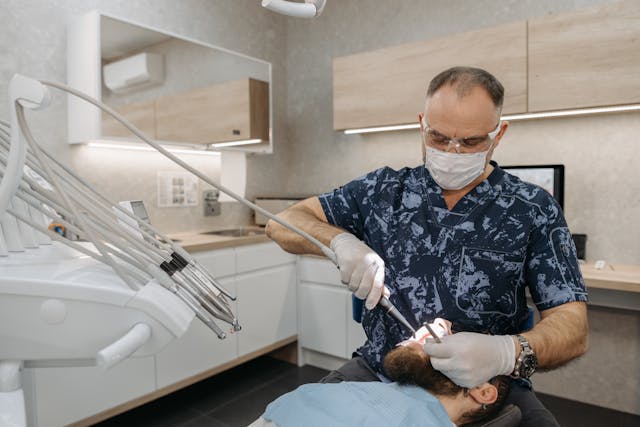Veneers, a popular tool in cosmetic dentistry, enhance smiles. Sicklerville’s Cosmetic Dentistry experts provide a comprehensive guide on veneers, covering types, history, procedure nuances, maintenance, cost, and durability. This guide aids potential patients in making informed decisions on veneers for their specific cosmetic needs.
Understanding Dental Veneers
Dental veneers, also termed porcelain veneers or dental porcelain laminates, are customized, slim shells of tooth-colored material to enhance tooth appearance. They’re adhered to the tooth’s front, modifying color, shape, size, or length.
The veneers consist of porcelain or resin composite. Porcelain veneers outperform resin in stain resistance and natural light reflection, while resin veneers are slimmer needing less tooth surface removal. Material selection is patient-dependent, guided by dentist’s advice and specific scenarios.
Alternatives to veneers include dental bonding and crowns. Dental bonding employs tooth-colored resin, hardened with a special light, offering a less invasive, cost-effective solution but with shorter lifespan. Crowns cover the entire tooth, providing a more extensive solution. Despite their benefits, neither may equal dental veneers in aesthetic appeal and lifespan.
The History Of Veneers
Veneers’ history, from simple beginnings to recent advancements, mirrors both cosmetic dentistry progress and evolving aesthetic and dental health standards. This path highlights key milestones in veneers’ evolution, illustrating its significant journey through time.
Evolution of Dental Veneers
The evolution of dental veneers has progressed from ancient beginnings to modern cosmetic dentistry, showcasing considerable advancements in dental technology and aesthetic methods. Initially, temporary veneers, made of acrylic, were utilized by actors for aesthetic purposes during films. The development and use of composite resins and porcelain marked a pivotal step in veneer technology, providing strength, endurance, and a natural look. Dental adhesives evolved concurrently with veneer innovations, enabling a secure, permanent fixture. Veneer application techniques transformed from requiring substantial tooth alteration to conservative methods with minimal tooth modification. Presently, veneer technology reflects customization trends in cosmetic dentistry, facilitating bespoke veneers for natural, aesthetically pleasing results.
Key Milestones in Veneers
Veneer history begins in the early 20th century with dentist Charles Pincus, who invented temporary veneers for Hollywood actors. This early innovation was followed by Dr. Michael Buonocore’s breakthrough in the 1950s and 60s, introducing acid-etched enamel for durable veneer adhesion. In the 1980s, veneers evolved further with the introduction of porcelain construction, mimicking the light-reflecting properties of natural teeth.
Veneers gained significant popularity in the early 21st century, becoming a symbol of status and beauty thanks to celebrities like Tom Cruise and Victoria Beckham. Today, veneer technology continues to advance with no-prep veneers and CEREC technology, providing less invasive and quicker procedures. These key milestones have transformed veneers from a Hollywood exclusive to a widely accessible dental procedure.
Different Types Of Veneers
Cosmetic dentistry offers several veneer types, each with unique benefits, catering to diverse aesthetic needs. Porcelain veneers, the most common, offer durability and a natural appearance, mimicking the light-reflecting properties of natural teeth and resisting staining. Composite resin veneers, less durable but more affordable, require less enamel removal. Lumineers, ultra-thin veneers, preserve natural tooth structure, but aren’t suitable for all cases. Prepless veneers, custom-made, require no reshaping, making the procedure reversible. The veneer choice depends on the patient’s dental health, aesthetic goals, and budget. With various options, practitioners can tailor treatments to individual needs.
The Veneer Procedure Explained
Transitioning from the exploration of veneer types to the procedure, we detail the veneer process step-by-step, from patient expectations to post-care tips. This knowledge equips potential patients for the process, ensuring superior veneer treatment outcomes.
Understanding the Veneer Process
The veneer process, while intricate, involves three main stages. First, a dental consultation is held to evaluate oral health and discuss aesthetic aspirations, considering veneer alternatives like bonding or crowns.
In the second stage, tooth prep occurs. Enamel removal creates space for the veneer and a rough surface for strong adhesion. A tooth impression is then sent to a lab for custom veneer creation.
The final stage is veneer placement. After fit confirmation, the veneer is bonded to the tooth with a special adhesive and solidified with a curing light. The veneer is polished for a natural look, contributing to the flawless smiles of celebrities who choose veneers.
Understanding the veneer process enables informed decisions about dental health and aesthetic goals, showcasing the transformative potential of contemporary cosmetic dentistry.
Post-Procedure Care Tips
To ensure the longevity of your veneers, maintain diligent oral hygiene and regular dental check-ups. Veneers, once attached, become part of your teeth, requiring daily brushing, flossing, and bi-annual dental visits for professional cleaning.
The color selection of veneers is vital for aesthetic appeal. Despite veneers’ resistance to stains, natural teeth are susceptible. Avoid a color mismatch caused by staining agents like coffee or wine through regular cleaning.
Post veneer placement, consider diet changes to prevent potential veneer damage. Despite veneers’ strength, hard foods like ice, nuts, or hard candy can cause chips or cracks. A softer diet aids in veneer protection and longevity.
Benefits Of Choosing Veneers
Opting for veneers yields benefits such as enhanced aesthetics and dental health. Veneers allow personal customization in terms of shape, size, and color, ensuring a natural integration with existing teeth. They also rectify dental issues like chipped, discolored, or misaligned teeth, thereby enhancing smile appeal and functionality. The popularity of veneers is due to their dual benefits of improving looks and health. Celebrity veneer transformations further showcase their effectiveness and aesthetic value. High-profile personalities in the entertainment industry have transformed their smiles with veneers, boosting their public appeal.
Potential Risks And Downsides
Veneers, despite their benefits, pose potential risks including irreversible procedure effects, tooth sensitivity, and veneer detachment. These risks are mitigated by a thorough dental health assessment by a competent cosmetic dentist before veneer recommendation, ensuring tooth suitability for the procedure and minimizing post-procedural complications like tooth sensitivity from excessive enamel reduction. Aftercare complications, such as veneer detachment or cracking due to improper oral care or excessive pressure, may occur. Regular dentist appointments are essential for veneer condition monitoring and prompt issue resolution, as veneers, while durable, are susceptible to wear and tear.
Maintenance And Care For Veneers
Maintaining veneers requires meticulous oral hygiene, involving regular brushing with non-abrasive toothpaste, flossing to remove plaque, and routine dental check-ups. Consumption of coffee, tea, red wine, and berries may discolour veneers. Rinsing mouth post-consumption or using a straw can minimize this discoloration. Veneer sensitivity, often resulting from enamel thinning during placement, can be managed by using toothpaste for sensitive teeth or seeking dentist-recommended treatments.
Veneer Lifespan And Durability
Veneer durability and lifespan is influenced by material quality, dental professional skill, and patient’s oral health habits. Understanding these factors can help extend veneer longevity, crucial for those considering this cosmetic dentistry option.
Understanding Veneer Longevity
Veneer longevity depends on material, dentist expertise, and patient oral hygiene. Custom veneers, made from quality materials, increase durability. Dental insurance often covers veneers due to their durability and oral health benefits. Porcelain or composite resin veneers last 10 to 15 years with proper care. Despite durability, veneers may damage from teeth grinding or hard chewing. Understanding these factors ensures long-lasting aesthetic and functional benefits.
Factors Affecting Durability
Veneer durability depends on material quality, dentist’s expertise, and oral hygiene. Superior materials like porcelain or composite resin extend veneer lifespan due to their longevity and stain resistance. The durability further hinges upon precise application by skilled dentists; expertly fitted veneers outlast improperly placed ones. Veneer color affects perceived durability; darker shades hide wear better than lighter ones. Material’s color stability is essential as discoloration can diminish aesthetic appeal. Despite artificiality, veneers need identical oral hygiene care as natural teeth for longevity, enhancing smiles and boosting confidence.
Maintenance for Prolonged Lifespan
Maintaining veneers for prolonged lifespan requires a well-structured routine. This routine includes understanding the impact of nutrition on veneers. Avoid hard, crunchy foods to prevent veneer damage. Instead, consume foods rich in calcium and vitamin D to support gum and tooth health, indirectly extending veneer lifespan.
Good oral hygiene is critical. Regular brushing, flossing, and professional cleaning help prevent plaque and discoloration, retaining veneer condition.
In case of veneer damage or dislodging, seek immediate dental assistance. Dentists can provide expert assessment and solutions, avoiding complications and extending veneer lifespan.
Cost Of Getting Veneers
Veneer costs hinge on factors such as quantity, type, and case complexity. Financing options exist for easier acquisition, including in-house or third-party payment plans with potential for low or no interest. Dental insurance may cover some costs if veneers serve restorative purposes, but not for purely cosmetic procedures. Confirm coverage with your insurance provider to understand out-of-pocket costs.
Real-Life Case Studies Of Veneers
Veneers can significantly transform smiles, as proven by real-life case studies. A case involves a woman who improved her discolored, misaligned teeth with veneers, enhancing her confidence.
Alternatively, a man chose composite bonding, a veneer alternative, for a natural look and cost-effectiveness, still achieving aesthetic improvement.
Tom Cruise, a celebrity example, improved his initially misaligned and discolored teeth with veneers, resulting in a brighter, aligned smile and enhanced persona.
These cases demonstrate veneers’ transformative potential and the availability of alternatives. Veneers and alternatives provide various solutions for those seeking smile improvement, requiring personalized approaches for unique cases.
Frequently Asked Questions
Can Veneers Change the Shape of My Face or Smile?
Indeed, veneers can modify your smile’s appearance through customizable shape and size. However, they don’t alter facial structure.
Do Veneers Feel Different Than Natural Teeth?
Veneers, initially, may present a different feel due to their smoothness. Over time, this sensation diminishes. Sensitivity from veneers should be slight, and their upkeep parallels that of natural teeth, facilitating an effortless transition.
Are There Any Foods or Drinks to Avoid With Veneers?
For veneer maintenance, bypass hard, crunchy foods and dark-colored drinks to prevent damage or discoloration. Initial taste sensitivity due to veneers usually normalizes over time.
How Do Veneers Affect Oral Health in the Long Term?
Veneers’ impact on long-term oral health depends on maintenance quality. Proper hygiene extends veneer lifespan, prevents decay beneath veneers, and enhances overall oral health. Regular dental check-ups are critical.
Is It Possible to Whiten Veneers Like Natural Teeth?
No, veneers cannot be whitened like natural teeth. Their maintenance excludes typical teeth whitening methods. Veneers, being stain-resistant, don’t react to standard teeth whitening treatments. A professional cosmetic dentist should address any discoloration.

































